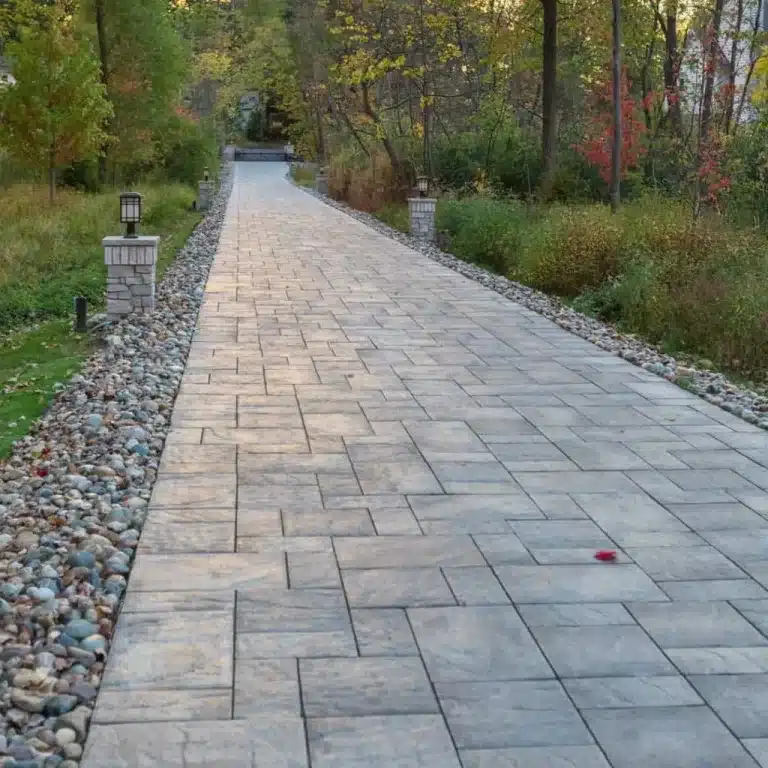Hardscaping's Influence From Patios to Pathways
Introduction:
When it comes to creating a captivating outside space, hardscaping is a fundamental component that frequently goes neglected. While lush green lawns and vibrant flowerbeds are undeniably attractive, hardscaping adds structure, functionality, and a touch of artistry to your outdoor oasis.

What Is Hardscaping?
Hardscaping incorporates and highlights, for example, decks, walkways, holding walls, pergolas, fire pits, and, surprisingly, embellishing stones. Dissimilar to landscaping, which includes living components like plants and trees, hardscaping gives design and perpetual quality to your outside space.
Benefits of Hardscaping
Low Maintenance:
Hardscaping requires minimal upkeep compared to plants and lawns. Once installed, it can withstand weather conditions, and you won’t need to worry about mowing, pruning, or watering.
Increased Functionality:
Patios, decks, and pathways create functional spaces for dining, lounging, or entertaining guests. Fire pits and open air kitchens can expand your living region and give a comfortable environment.
Erosion Control & Visual Appeal:
- Retaining walls and pavers can help prevent soil erosion, which can be particularly beneficial on sloped landscapes.
- Hardscape elements add aesthetics to your outdoor space, enhancing its overall beauty and increasing property value.
Hardscape Design Ideas:
A very much planned patio can act as the point of convergence of your open air region. Consider utilizing materials like normal stone, pavers, or stepped concrete for a modern look. Add outdoor furniture, potted plants, and cozy lighting to make it inviting.
Fire Features & Water Features:
- Fire pits and fireplaces are perfect for extending outdoor enjoyment into the cooler seasons.
- Fountains, ponds, and waterfalls add a tranquil touch to your hardscaped space.
Hardscaping Successful Tips
Plan Carefully & Material Selection:
Before starting any hardscaping project, create a detailed plan. Think about your space, spending plan, and aesthetic preferences. Talk with an expert if necessary.Choose materials that supplement your home’s design and the encompassing scene. Guarantee they are strong and climate safe.
Proper Drainage & Maintenance:
- Adequate drainage is critical to forestall water pooling or disintegration issues.Incorporate drainage solutions into your design.
- While hardscaping requires less maintenance than plants, it’s not maintenance-free.
Features:
Hardscaping plays a crucial role in the design and functionality of outdoor spaces, transforming them from plain areas into functional and aesthetically pleasing environments. From patios to pathways, hardscape elements add structure, utility, and character to your outdoor living spaces. Here’s a closer look at hardscaping’s influence on these features:
Patios:
Foundation:
Hardscaping materials like concrete, pavers, stone, or brick create a solid and stable foundation for your patio. These materials are sturdy and can endure different weather patterns, making them appropriate for long haul use.
Design Flexibility:
Hardscape materials come in different shapes, sizes, and varieties, considering unending plan prospects. You can create intricate patterns or simple, clean lines to match your aesthetic preferences.
Functionality:
Patios provide outdoor seating and entertainment spaces. Incorporating hardscape elements such as built-in seating walls, fire pits, or outdoor kitchens can enhance their functionality and make them ideal for hosting gatherings or relaxing.
Aesthetics:
Enhancing Curb Appeal:
Hardscape elements like well-designed patios and pathways can significantly boost your property’s curb appeal. They create visually appealing features that make your outdoor space more inviting.
Landscape Integration:
Hardscaping should complement the natural landscape. Thoughtful design can seamlessly integrate hardscape elements with the existing plants, trees, and other outdoor features.
Personalization:
Hardscaping allows for personalization and customization. You can add decorative touches like mosaic designs, engraved stones, or artistic borders to make your outdoor space unique and reflective of your style.
- Hardscaping materials are chosen for their durability and longevity.
Hardscapings Materials:
Hardscaping materials are used in landscaping to create non-living elements such as walkways, patios, walls, and other structural features. There are various materials commonly used in hardscaping, each with its own characteristics, advantages, and aesthetic appeal. There are many materials some common hardscaping materials include:
Brick:
Bricks can be used in various hardscaping applications, including pathways, driveways, patios, edging, and retaining walls. It is often used for pathways, patios, and edging. Brick comes in various colors and patterns, providing design flexibility.
Stone:
Natural stone, such as flagstone, granite, limestone, and slate, adds a rustic and natural appearance to hardscaping projects. Stone is used for pathways, patios, walls, and even outdoor fireplaces.
Wood:
Wood can be used for decking, pergolas, fences, and other hardscaping features. Pressure-treated wood is also used but may require periodic maintenance. One of the key advantages of using wood in hardscaping is its ability to seamlessly blend with various landscape designs.
Gravel:
Gravel is often used for driveways, pathways, and as a base material for other hardscaping features. It provides excellent drainage and is relatively low-maintenance.
Metal:
Metal materials, such as steel and aluminum, can be used for modern or industrial-style hardscaping features, including edging, planters, and pergolas. Their strength ensures longevity, making them ideal for pathways, fences, and retaining walls.
Concrete Blocks:
Concrete blocks, such as cinder blocks or concrete retaining wall blocks, are used for creating walls, raised garden beds, and other structural elements. They can be stacked to create retaining walls, garden borders, or raised planters, adding both functionality and aesthetic appeal to outdoor spaces.
Boulders and Rocks:
Large boulders and rocks are often used in naturalistic landscaping to create retaining walls, accent features, or as decorative elements in gardens.
Choosing the Right hardscapings Material:
Choosing the right hardscaping material is essential for creating a durable and aesthetically pleasing outdoor space. Hardscaping materials include a wide range of options such as concrete, pavers, natural stone, gravel, wood, and more. There are some main steps to help you select the right hardscaping material:
- Some materials, like concrete, are well-suited for all weather conditions, while others may deteriorate quickly in extreme cold or heat
- Each material has a unique appearance, from the sleek and modern look of concrete to the natural and rustic appeal of stone.so be careful and unique in your thoughts.
- Think about the level of maintenance you are willing to commit to. Consider your time and willingness to maintain the hardscape.
- Natural stone and concrete tend to be more durable and long-lasting, while wood and certain types of pavers may require more frequent replacement or repairs.
- If you’re unsure about the best hardscaping material for your project, consult with a hardscaping and landscaping designer or contractor.






